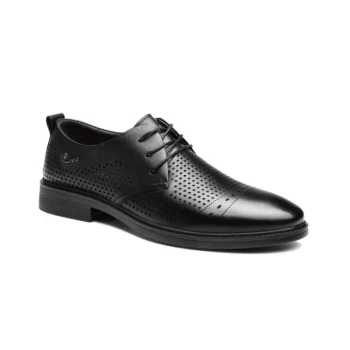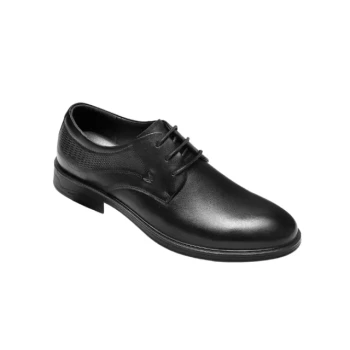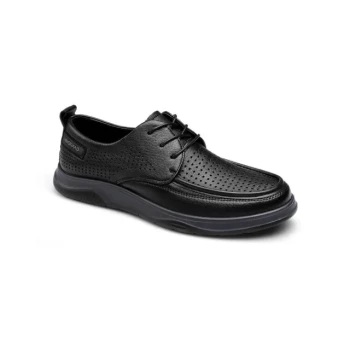At a glance, the difference is clear, but the core structural distinctions between formal and casual shoes lie in their silhouette, sole construction, and heel. Formal shoes are defined by a sleek, compact structure with thin, often leather soles and a separate heel, designed to complement sharp, tailored clothing. Casual shoes, in contrast, feature a bulkier, more relaxed shape with thicker, typically rubber soles built for comfort and versatility.
The fundamental difference is a matter of design philosophy. Formal shoe structure prioritizes clean lines and elegance to harmonize with professional or ceremonial attire, while casual shoe structure prioritizes function, comfort, and a relaxed aesthetic for everyday environments.
The Anatomy of a Formal Shoe: A Focus on Sleekness
The entire structure of a formal shoe is engineered to create a refined and unobtrusive silhouette. This design complements the clean lines of suits and dress pants without drawing undue attention.
The Sleek Silhouette
A formal shoe has a compact and narrow profile. It is built with sharp lines and clean, defined edges to create a sense of precision and elegance.
The Traditional Foundation
The sole is a key differentiator. Formal shoes traditionally feature thin leather soles, which contribute significantly to their slim profile.
The Separate Heel
A defining structural element is the separate heel. This is a distinct component attached to the sole, which creates a slight elevation and a classic, sharp look.
Minimalist Edging
To enhance the sleek appearance, the sole on a formal shoe often has minimal extension beyond the sides of the upper. This keeps the visual line clean and unbroken from pants to floor.
The Anatomy of a Casual Shoe: Built for Versatility
Casual shoes, like sneakers or loafers, are designed with a completely different set of priorities. Their structure favors a relaxed appearance, durability, and all-day comfort.
The Relaxed Profile
Casual shoes are generally bulkier and less structured. Their overall shape is softer, with fewer sharp lines, reflecting their informal purpose.
The Modern Sole
The vast majority of casual shoes use thicker rubber soles. Rubber provides superior cushioning, grip, and durability compared to traditional leather, making it ideal for varied daily activities.
The Integrated Footprint
Unlike the distinct, separate heel of a formal shoe, a casual shoe's sole is often a single, integrated piece. It can be flat or feature a thicker, chunkier design that provides a more grounded and substantial look.
Understanding the Trade-offs
The structural choices in footwear design are not arbitrary; they represent a direct trade-off between aesthetic formality and practical function.
Formal: Elegance Over Endurance
The thin leather soles and sleek construction of formal shoes are visually elegant but can be less comfortable for extended walking. They are also more susceptible to wear and damage from abrasive surfaces and moisture.
Casual: Comfort Over Convention
The thick rubber soles and relaxed fit of casual shoes offer superior comfort and durability for everyday wear. However, this bulky, functional structure lacks the refinement required to properly complement formal tailoring.
Matching Structure to Setting
Your choice should be dictated by the environment and the clothing you are wearing.
- If your primary focus is complementing tailored attire (suits, dress pants): Choose a shoe with a sleek structure, a distinct heel, and a thin sole to maintain a sharp, professional line.
- If your primary focus is comfort and everyday versatility: Opt for a shoe with a more relaxed shape and a thicker, more durable rubber sole that can handle daily wear.
Understanding these structural fundamentals empowers you to select the right footwear with intention and confidence.
Summary Table:
| Feature | Formal Shoes | Casual Shoes |
|---|---|---|
| Silhouette | Sleek, narrow, sharp lines | Bulky, relaxed, soft lines |
| Sole | Thin leather sole | Thick rubber sole |
| Heel | Separate, distinct heel | Often integrated, flat or chunky |
| Primary Focus | Elegance, complements tailoring | Comfort, versatility, durability |
Ready to source the perfect footwear for your market?
As a large-scale manufacturer, 3515 produces a comprehensive range of footwear for distributors, brand owners, and bulk clients. Whether you need the sleek structure of formal shoes or the comfortable build of casual styles, our production capabilities encompass all types of shoes and boots to meet your exact specifications and volume needs.
Contact our team today to discuss your manufacturing requirements and discover how we can add value to your supply chain.
Related Products
- Wholesale Leather Derby Shoes Manufacturer | Customizable Business & Dress Footwear
- Wholesale Perforated Comfort Dress Shoes | Custom Derby Shoe Manufacturer
- Custom Manufactured Air Cushion Leather Business Shoes for Wholesale
- Wholesale Breathable Perforated Leather Derby Dress Shoes for Custom Brands
- Wholesale Comfortable Business Casual Shoes Custom Manufacturing
People Also Ask
- What are the benefits of calf leather for dress shoes? Unmatched Elegance & Comfort
- What is business casual shoes? Master the Perfect Blend of Professional Style and Comfort
- Why are quality shoes important for overall appearance? The Anchor to a Polished Impression
- What are some common styles of dress shoes? Master the Language of Formality
- What should be known about genuine leather for shoes? Don't Be Misled by the Label



















